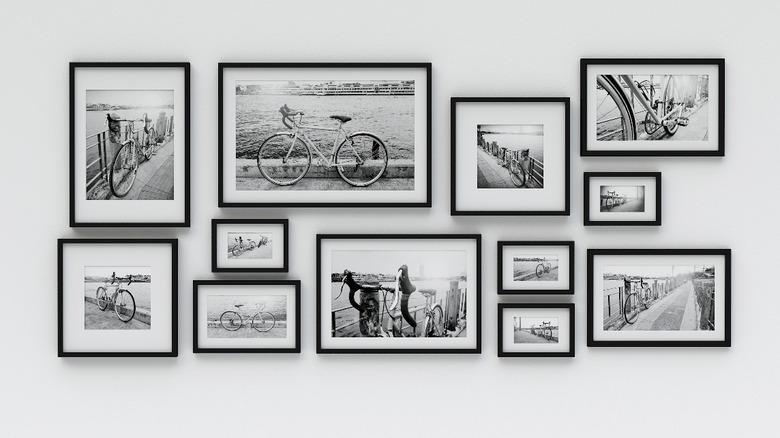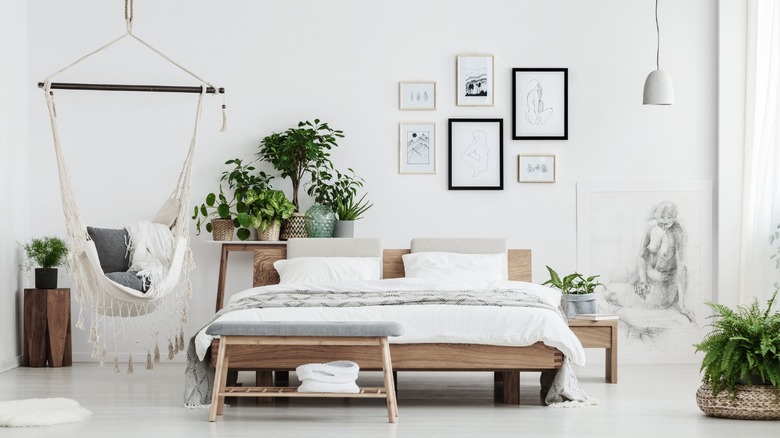How To Create The Perfect Gallery Wall
A gallery wall is the perfect manifestation of memory and meaning, told in your voice and style. Per Insider, it's one of the most cost-effective ways to make a statement on an empty wall. More than the sum of its parts, multiple images create a story, and it's nice to know life doesn't have to be distilled down to a favorite photograph or two — the more the merrier. A gallery wall requires determination and commitment — to a design theme, to the artwork, and to the action of installing it from the first frame to the last. Yet, it's not as hard as it looks, and like the treasures themselves, it is accomplished piece by piece.
Image options are plentiful: photography, antique prints, paintings, children's artwork, book pages, and even wallpaper. In need of inspiration? Flip through some shelter magazines or design apps to find themes or layouts you find attractive. House Beautiful suggests experimenting with mixing various styles and kinds of art. Select images that make you want to look longer, and work well together. Don't be too prescriptive — choose what you love and they will harmonize — as well as speak to the rest of your aesthetic. Lastly, don't be afraid to combine different materials, objects, and textures. But steel yourself for crooked pictures — they're part and parcel of a gallery wall.
Choose the theme of your gallery wall
First, decide what you want to feature on your gallery wall. Would you like to create an oversized family album to showcase special occasions like a wedding, birth, or travel and vacation experiences? This type of imagery puts memories in plain sight, yet also reminds us that there are more to make — a pictographic version of a yearly height measurement penciled onto a doorframe.
Perhaps you're a nature enthusiast who loves the idea of a wall of curiosities, abuzz with botanicals, birds, and butterflies. Or maybe you have a mechanical mind, excited by gears, wheels, and cogs of all kinds. Or you swoon imagining a Paris salon-inspired gallery of figures, vintage city maps, and luscious still lifes. Maybe your goal is to highlight a color scheme, or celebrate a specific hue; it's a lovely tale one can weave with collective color. The Spruce explains that a common theme will help your display to appear less cluttered and more cohesive.
Choose the style of your gallery wall
The feeling you're after is as important as the features of your gallery wall. For example, choosing one frame style creates a clean and straightforward design. Carrying the same matte throughout different frames ties them together visually, while providing variation. Use a consistent size to plot a neat, precise grid. Or choose random sizes and frames for interest, placing pieces haphazardly for a mad-cap look akin to a wildflower garden. Limit images to black and white photography to create graphic and contemporary punch; or curate a mood with toned or boldly saturated filters.
Small pieces invite closer inspection, and counterintuitively, fill big spaces in their quiet manner. Symmetric compositions are classical, whereas an asymmetric yet balanced layout reads modern. In addition, according to House Beautiful, certain frames are suited to specific interior styles; light and neutral frames denote a Scandinavian aesthetic, while black frames are perfect for industrial spaces, and aged metals and woods read traditional.
Reserve the right not to choose
Maybe you're not a planner, and that's fine (until we get to the hanging part). Spontaneity and eclecticism in design can inspire some energetic spaces instead of following a set of rules; let your inner compass be the guide when curating pieces.
Don't feel limited to flat, framed artwork, either; if it can be suspended on the wall, it's game. A bottle full of vacation sand hung with twine relates to an ocean image in the most sensitive of ways; a physical item nearby a similar one in a painting sets up an interplay between mediums and dimensionalities. Mirrors reflect light, and insert other areas of the room into the composition; a wall sculpture brings depth and variation to the whole. Insider suggests interspersing unframed pieces or a textural fabric remnant among the polished works. Unexpected combinations create layers of interest and evoke emotion, and per The Spruce, they result in a multi-faceted design with an excess of style.
They're not just for boring walls
Gallery walls are for more than adding interest to boring walls. Restore balance in an off room by using the dimensions of the arrangement to counteract another element in the space, such as large windows, or an awkward floor plan. Or create a focal point in a room lacking one; per Apartment Therapy, a focal point is an impactful way to fashion a harmonious and sophisticated space, helping to set the whole mood — if it's missing, you'll feel it. Architectural features like alcoves, fireplaces, wainscoting, and panelling can be highlighted; wall molding that outlines framed paintings is a classical, elegant design treatment. The attention a gallery wall garners can be a diversion from detracting elements, like exposed pipes or ductwork.
Add energy via color to a neutral space; introduce a complementary hue to create interest and equilibrium; impart a moment of visual rest among a busy interior? A gallery wall can do that too.
Pick the location of your gallery wall
According to House Beautiful, a hallway, living room, or staircase are the most common areas for a gallery wall. But they're lovely in a home office, bedroom, or breakfast nook — even in the bathroom, where close walls and idle time are the perfect situation for visual entertainment. Choose appropriate imagery to tell a story: vintage cosmetic ads in the closet, citrus-themed paintings in the kitchen, movie memorabilia in the media room. The empty wall above the sofa is prime real estate for a display. And a nursery wall provides a fun decorating opportunity with imagery that's easy to change out as the child grows; The Spruce recommends a calm vibe — nothing too bold or bright.
Per The New York Times, gallery walls are just as suitable in small apartments as in large homes because they don't occupy any floor space. In fact, the visual height added can make a room appear taller, while the interesting treatment serves to distract from limited square-footage.
Source the pieces for your gallery wall
Image sources for a gallery wall are endless. Free photography platforms and public domaine archives are excellent ways to obtain affordable imagery; the Smithsonian has made almost three million images available for public use, as part of its Smithsonian Open Access initiative.
Additionally, flea markets and thrift stores are fun to scour for second-hand or vintage paintings and prints, and are relatively inexpensive. Antique shops and resellers offer unique pieces, sometimes with provenance. Professional portraits or candid snapshots create a family album, particularly nice modernized in oversized black and white photographs. Book illustrations, wallpaper samples, and even tote bags and t-shirts can be eye-catching behind glass. Shadow box frames are deep enough to house physical objects, like baseballs, dried flowers, or a beaded clutch, for example.
It's better to start with too many pieces and edit down. For those who are pressed for time or don't enjoy the hunt, there are art and framing sites that provide curated, themed packages (via House Beautiful).
Plan your gallery wall
Consider first whether you'll want to incorporate shelving for leaning artwork or showcasing small objects. Or, if you'll be adding wall sculpture or unconventional items, that may require a specialized hanging method, like an antique game board, for example.
Lay the pieces across the floor on a sheet of craft paper the size of the prospective gallery wall; The New York Times recommends working from the center outward, beginning with the largest piece. If you're creating an asymmetrical arrangement, you'll want to start slightly off to one side and then balance it later, so the composition doesn't feel too contrived. Chart a consistent amount of space around each frame; in precise grids this is especially important. Play with the presentation until the desired flow and design is achieved, then trace around the objects to create a template; It's prudent to mark the placement of hooks and wires onto the template for easier installation later. This preliminary work will save your wall a lot of unnecessary holes.
Plot your gallery wall
If the wall space is too large to use the template method there are some alternatives. Arrange the items on the floor, taking a photo once the composition looks right; use paper cut-outs and removable painters' tape, shuffling each piece around on the wall. Per Better Homes & Gardens, again mark the hanging wire or hook onto the paper, or map the pieces out with painters' tape applied directly to the wall.
Gather nails and picture hooks rated for the appropriate weight, a pencil, hammer, measuring tape, level (a laser level is preferred), and spackle to fill extra holes. You'll want the center of the display to be about 57 inches from the floor, but you may need to adjust for ceiling height, or the dimensions of your composition. Anything particularly heavy should be mounted to studs.
Start hammering away, using your level to keep things on track. We recommend placing plastic bumpers on the back corners of the pieces before hanging them; it will help keep things from shifting with every jostle and shake of the walls.








